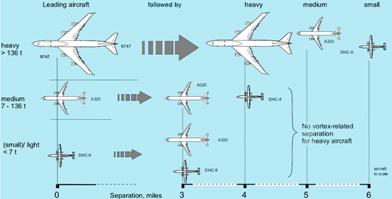Wake Vortex Encounter
The ultimate objective of this area of research is to establish safety margins for the positioning of rotorcraft approach trajectories and their FATO's (Final Approach and Take-Off areas).
 |
|
ICAO separation rules for Wake Vortex |
Longitudinal separation for the protection against wake vortex encounter has been in operation since the 1970’s with the standard ICAO weight-categorised separation rules that apply for aircraft under IFR conditions. The premise of these separations is that the distances give sufficient separation on final approach such that the wake vortices of the lead aircraft have moved out of the flightpath of the following aircraft or weakened enough such that it is no longer a significant threat. For SNI, the situation is more complex as it requires safe lateral separation as well as longitudinal separation. This is not only because the operations are adjacent, but because they are also independent and any combination of position of aircraft and rotorcraft is possible along their respective prescribed flightpaths. This means that wake vortex separation rules for SNI must consider the entire final approach flightpath and all wind vectors. Of course, the simplest solution to this problem is to ensure large separations of the traffic such that the possibility of an encounter is improbably remote. However, this requirement has a number opposing constraints that vary with each and every airport. These include where the rotorcraft flightpaths can be placed within the existing traffic, terrain and obstacle constraints, FATO and runway positioning constraints and fly-over constraints (noise abatement). Once all these criteria are taken into account it is often quite difficult to select the ‘ideal’ positioning from a wake vortex separation point of view. These issues demand greater knowledge of the rotorcraft-wake vortex interaction. This includes not only understanding at the aerodynamics level but also understanding of the rotorcraft’s overall flight-dynamic response and how a pilot reacts to an encounter.
In particular, an assessment of the ‘risk’ of an encounter with a wake vortex must be made. This consists of two main tasks:
a) What is the severity when meeting a vortex of a given strength in a number of different scenarios?
b) What is the probability of encountering a wake vortex in different regions of a given airport and what will its strength be?
Both of these tasks represent a significant undertaking, especially b) which relies heavily on being able to predict or measure the complex motion and decay of the vortices after they are generated. Part a) also requires a further breakdown, as the question of how to measure the severity of an encounter has yet to be answered. In addition, can the severity of an encounter and the ability to overcome an encounter be linked to original handling qualities (HQ’s) of the encountering rotorcraft, and what level of HQ characteristics such as control power might be required to recover from an encounter?
How does one measure severity? This is one of the most critical issues for this study. This implies that a metric or measure is needed to enable a method of quantifying how ‘bad’ or severe a particular encounter is, or perhaps, is likely to be. In the fixed-wing domain, a number of criteria have been used or proposed with reasonable success including a NASA ‘bank angle criteria’ and a ‘roll control’ criterion. The premise for both these criteria is that the disturbance from a wake vortex encounter (WVE) is primarily a rolling disturbance which is reasonable for conventional fixed-wing aircraft flying along parallel tracks. For rotorcraft, the interaction is more complex and the disturbance is in multiple axes. Furthermore, the proposed SNI operations allow for the potential of much more varying encounter geometries (i.e. parallel, crossing, oblique) especially as the new OPTIMAL procedures will feature steeper final approach glideslopes for rotorcraft (i.e. 6+ degrees).
| If aeroplane and/or helicopter mass are |
Distance between FATO edge and runway or taxiway edge |
|
up to but not including 2,720 kg |
60m |
|
2,720 kg up to but not including 5,760 kg |
120m |
|
5,760 kg up to but not including 100,000 kg |
180m |
|
100,000 kg and over |
250m |
The only current criteria are for VMC rotorcraft operations near to a runway and are given in ICAO standards in the table to left [1]. It is proposed that by using the concept of vortex 'severity' it is the risk for operations around a runway can de defined by combining severity assessments with wake vortex transport and decay data. Using this approach, recommendations for the approach and go-around procedures and FATO separations can be made.
1. ICAO International Standards and Recommended Pratices: Aerodromes, Annex 14, Vol II: Heliports